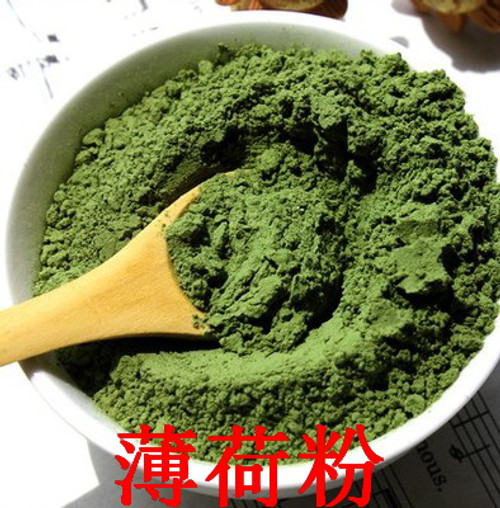Product Overview
Parts used: Dried aerial parts
TCM category: Cool/Acrid herbs that release the Exterior
TCM nature: Cool
TCM taste(s): Pungent
Meridian affinity: Liver Lung
Scientific name: Mentha haplocalyx
Other names: Field mint, Wild mint
Use of wild mint (Bo He) in TCM
Please note that you should never self-prescribe TCM ingredients. A TCM ingredient is almost never eaten on its own but as part of a formula containing several ingredients that act together. Please consult a professional TCM practitionner, they will be best able to guide you.
Preparation: Remove the old stems and impurities, soak slightly in water and dry at low temperatures
Dosage: 3-6g
Main actions according to TCM*: Relieves the Exterior and disperses Wind-Heat. Clears Wind-Heat from the head, eyes and throat. Allows the release of toxins from the skin. Moves Stagnant Liver Qi
Primary conditions or symptoms for which wild mint may be prescribed by TCM doctors*: Headache Sore throat Mouth ulcers Rubella Measles Chest congestion Uveitis
Contraindications*: Mint should be used with caution by those with Yin Deficiency Heat and spontaneous sweating. This herb should not be used by nursing mothers as it may slow lactation.
Common TCM formulas in which wild mint are used*:
For measles and rashes combine wild mint with greater burdock fruits (Niu Bang Zi), bugbane rhizomes (Sheng Ma) and kudzu roots (Ge Gen).
For Exterior Wind-Heat with symptoms of headache, colds, sore throat combine wild mint with chrysanthemum flowers (Ju Hua), platycodon roots (Jie Geng) and greater burdock fruits (Niu Bang Zi).
For External Wind Heat with fever, sore throat, chills and red eyes combine wild mint with mulberry leaves (Sang Ye), chrysanthemum flowers (Ju Hua), forsythia fruits (Lian Qiao) and platycodon roots (Jie Geng).
For severe colds, flu or upper respiratory tract infections combine wild mint with honeysuckle flowers (Jin Yin Hua), forsythia fruits (Lian Qiao), platycodon roots (Jie Geng), greater burdock fruits (Niu Bang Zi), fermented soybeans (Dan Dou Chi), lophatherum herbs (Dan Zhu Ye), common reed rhizomes (Lu Gen), liquorice (Gan Cao), notopterygium roots (Qiang Huo) and woad roots (Ban Lan Gen).
For Wind-heat with yin deficiency combine wild mint with angular solomon's seal roots (Yu Zhu) and fermented soybeans (Dan Dou Chi).
Key TCM concepts behind wild mint (Bo He)'s properties
In Traditional Chinese Medicine (TCM), wild mint are plants that belong to the 'Cool/Acrid herbs that release the Exterior' category. Herbs that release the Exterior aim to to treat the early stages of diseases that affect the upper respiratory tract, the eyes, the ears, the nose, the throat or the skin. TCM believes that External diseases such as colds or allergies can only invade the body if the External environment overwhelms our Wei Qi (the TCM version of the immune system). In order to counteract this invasion Cool/Acrid herbs aim to induce sweating by dilating our capillary pores so that they release more sweat. The belief is that this will expel the disease from the body and stop it from invading further.
As suggested by its category wild mint are plants that are Cool in nature. This means that wild mint tend to help people who have too much "heat" in their body, although with less effect than a plant that would be Cold in nature. Balance between Yin and Yang is a key health concept in TCM. Those who have too much heat in their body are said to either have a Yang excess (because Yang is Hot in nature) or a Yin deficiency (Yin is Cold in Nature). Depending on your condition wild mint can help restore a harmonious balance between Yin and Yang.
Wild mint also taste Pungent. The so-called "five elements" theory in Chinese Medicine states that the taste of TCM ingredients is a key determinant of their action in the body. Pungent ingredients like wild mint tend to promote the circulations of Qi and body fluids. That's why for instance someone tends to sweat a lot when they eat spicy/pungent food.
The tastes of ingredients in TCM also determine what organs and meridians they target. As such wild mint are thought to target the Liver and the Lung. In TCM the Liver is often referred as the body's "general" because it is in charge of regulating the movements of Qi and body fluids. It also takes a leading role in balancing our emotions. In addition to performing respiration, the Lungs are thought to be a key part of the production chain for Qi and the body fluids that nourish the body.
Use of wild mint (Bo He) as food
Wild mint are also eaten as food. It is used as an ingredient in dishes such as Tabouleh or Cucumber & mint relish.









